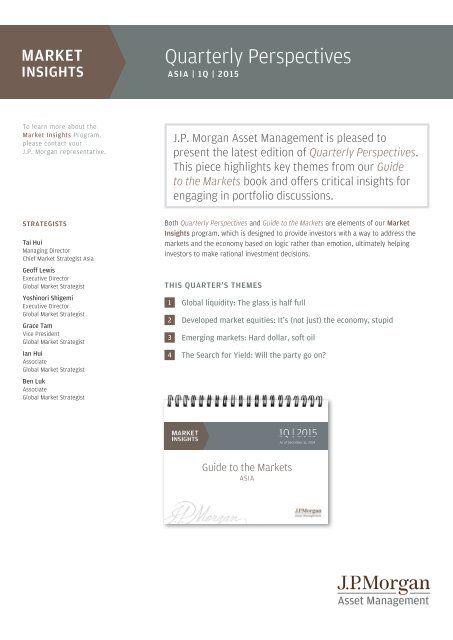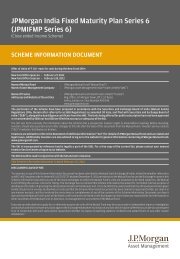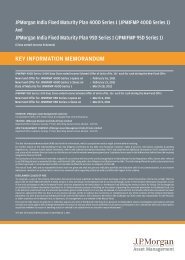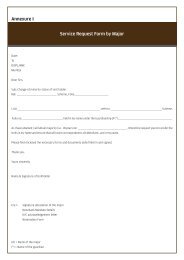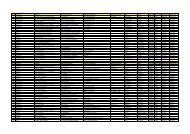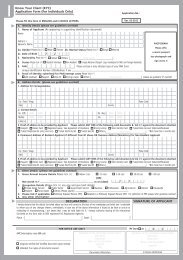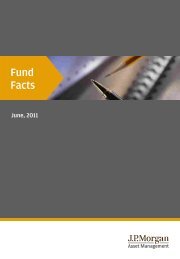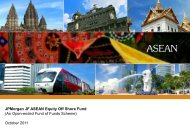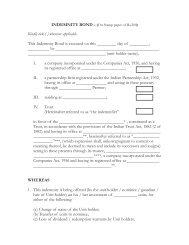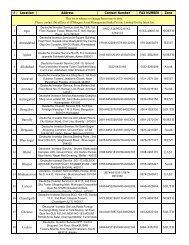download the PDF - JP Morgan Asset Management
download the PDF - JP Morgan Asset Management
download the PDF - JP Morgan Asset Management
Create successful ePaper yourself
Turn your PDF publications into a flip-book with our unique Google optimized e-Paper software.
MARKETINSIGHTSQuarterly Perspectives2 Developed market equities:It’s (not just) <strong>the</strong> economy, stupidTaking a stance on developed market equitiesWith 80% of MSCI AC World Index’s market capitalization in <strong>the</strong> U.S., Europe and Japan, itis important that investors take a position in <strong>the</strong>se markets in order to achieve somediversification in <strong>the</strong>ir portfolios. In 2014, <strong>the</strong> U.S. came away as a clear winner even asinvestors worried about valuations throughout <strong>the</strong> year. Japanese equities were given anew lease on life by <strong>the</strong> surprise announcement of additional money printing by <strong>the</strong> Bankof Japan (BoJ) at <strong>the</strong> end of October. Europe was dragged down by weak economictrends, despite <strong>the</strong> European Central Bank’s (ECB) pledge to re-engage in quantitativeeasing. In this article, we look at <strong>the</strong>se markets beyond <strong>the</strong> prevailing sentiment towards<strong>the</strong>ir domestic economies.U.S.: Sturdy economic growth with profitsOut of <strong>the</strong> three developed economies, <strong>the</strong> U.S. has <strong>the</strong> most robust macroeconomicbackdrop. After several years of de-leveraging by both <strong>the</strong> household and corporatesectors, <strong>the</strong> economy now has a stronger footing to expand. This boosts <strong>the</strong> FederalReserve’s (Fed) confidence in going ahead with monetary policy normalization, includingstarting to raise interest rates in 2015, albeit at a gradual pace.The corporate sector has also delivered steady earnings growth. S&P 500 earningsgrowth in Q3 2014 was around 10% year-on-year, with margin expansion contributingmore than revenue growth, as shown on page 34 of <strong>the</strong> Guide to <strong>the</strong> Markets – Asia.OVERVIEWU.S. equities led <strong>the</strong> developed market(DM) equities asset class in 2014. Thisreflected solid economic growth andconsistent corporate earnings growth.In 2015, <strong>the</strong> outlook for U.S. equitiesremains well supported, even thoughthis is a well-known story. Pessimism onEurope due to its economic downturnignores <strong>the</strong> fact that <strong>the</strong> region isgetting more help from low interestrates, a weakening euro and reducedfiscal austerity.Japanese yen depreciation is definitelyhelpful for Japanese equities, butcompetitive companies and a drive forbetter corporate governance should alsobenefit equity investors.United States: Sources of Earnings and Corporate ProfitsU.S. GDP and S&P 500 Year-over-Year EPS GrowthGrowth broken into revenue growth and margin expansion, quarterly50%25%0%Margin Share of EPS GrowthRevenue Share of EPS Growth34GTM - AsiaClickYear-over-year % changeGDP growth6%4%2%0%U.S. earnings growth is stilllargely derived from marginexpansion, ra<strong>the</strong>r than revenuegrowth.-25%-2%-4%Eq quities-50%-6%'95 '96 '97 '98 '99 '00 '01 '02 '03 '04 '05 '06 '07 '08 '09 '10 '11 '12 '13 '14S&P 500 Sector Forward EPS GrowthBuybacks and M&A ActivitiesEPS Growth (%) as of 12/2014USD BillionsUSD Billions, 4-quarter moving average1,60018030% 2014M&A Activities*Buybacks21% 20151,20012%1203%800-6%60-15%4000'00 '02 '04 '06 '08 '10 '12 '140Source: FactSet, Standard & Poor’s, BEA, J.P. <strong>Morgan</strong> <strong>Asset</strong> <strong>Management</strong> “Guide to <strong>the</strong> Markets – Asia 1Q 2015.”(Top) EPS based on operating earnings per share. 2Q14 figures are Standard & Poor’s estimates and based on company filings as of 30/6/14. 1Q09, 1010 and 2Q10 reflect -101%, 92% and 51%growth, respectively, in operating earnings and are cut off to maintain a more reasonable scale.* M&A activity is <strong>the</strong> quarterly value of deals completed.Data reflect most recently available as of 31/12/14.Source: Guide to <strong>the</strong> Markets - Asia, page 344 | Quarterly Perspectives: 1Q 2015
This consistent earnings momentum has helped to address concerns about highvaluation and continues to push S&P 500 to record highs. Given <strong>the</strong> U.S. growthperformance, especially in corporate capital expenditures, it is reasonable to expectearnings growth momentum to extend into 2015.What are <strong>the</strong> challenges to U.S. equities? Ongoing U.S. dollar (USD) strength could putsome pressure on companies’ overseas profits when translated back into USD. Thecurrent bout of weak oil prices could also hurt <strong>the</strong> material and energy sectors, althoughthis helps consumption by raising disposable income. The lack of revenue contribution tooverall earnings growth is also a disappointment, especially as company profit marginsare already at cyclical highs. None<strong>the</strong>less, we believe <strong>the</strong> historical relationship betweeneconomic growth and revenue growth should start to play out more prominently in 2015.Europe: Downside protection to counter downbeat sentimentEuropean equities’ disappointing performance in 2014 was largely brought on byrenewed concerns over <strong>the</strong> region’s economy returning to contraction after a false dawnearlier in <strong>the</strong> year. This pessimism on poor economic performance continues to be one of<strong>the</strong> biggest challenges for European equities, but <strong>the</strong>re are several factors that canprovide some support in <strong>the</strong> new year.The ECB’s pledge to push ahead with quantitative easing has yet to kick-start an upturnin <strong>the</strong> credit cycle. However, this has already started a push to weaken <strong>the</strong> euro, as wellas pushing interest rates lower, as illustrated on page 28 of <strong>the</strong> Guide to <strong>the</strong> Markets –Asia. A cheaper euro helps exporters to improve <strong>the</strong>ir competitiveness overseas or allow<strong>the</strong>m to enjoy bigger profits from overseas sales. Lower interest rates help to reducedebt servicing costs. Meanwhile, fiscal austerity measures, ei<strong>the</strong>r via higher taxes orspending cuts, are being reduced and, hence will be less of a drag on economic growth.These favorable conditions may not bring a V-shape recovery to Europe, but <strong>the</strong>y shouldprovide some support to corporate profitability in <strong>the</strong> medium term.conomyGlobal EcEurope: Monetary PolicyECB Balance Sheet and Euro REERReal broad effective exchange rate (REER)EUR Trillions115 ECB Balance Sheet 1.2(inverted scale)110 1.61052.0100Euro REER95 2.890'08 '09 '10 '11 '12 '13 '142.43.2ECB Bank Lending Survey ClickSupply and DemandNet % of banks reporting positive credit demand / supply28GTM - Asia80%StrongerHousehold Credit DemandDemand /Household Credit Standards60%TighteningCorporate Credit DemandCorporate Credit Standards40%Credit20%0%-20%WeakerDemand /-40%LooseningCredit-60%'04 '05 '06 '07 '08 '09 '10 '11 '12 '13 '14The ECB’s actions have yet toturn <strong>the</strong> region’s credit cyclebut low interest rates and aweakening euro are helpful.Sovereign Funding Costs10-year benchmark bond yields (%)15%12%9%6%3%0'12 '13 '1431/12/14 31/12/14Greece 9.4% UK 1.8%Portugal 2.7% Spain 1.6%U.S. 2.2% France 0.8%Italy 1.9% Germany 0.5%Eurozone Bank LendingYear-over-year % change15% Corporates12%9%6%3%0%-3%TotalHouseholds-6%'04 '05 '06 '07 '08 '09 '10 '11 '12 '13 '14Source: ECB, Bloomberg, FactSet, J.P. <strong>Morgan</strong> <strong>Asset</strong> <strong>Management</strong> “Guide to <strong>the</strong> Markets – Asia 1Q 2015.”(Bottom Left) Greece’s 10-year benchmark bond yield reached a peak of 32% in Jan 2012 and is cut off to maintain a more reasonable scale.Data reflect most recently available as of 31/12/14.Source: Guide to <strong>the</strong> Markets - Asia, page 28J.P. <strong>Morgan</strong> <strong>Asset</strong> <strong>Management</strong> | 5
MARKETINSIGHTSQuarterly PerspectivesJapan: Looking beyond <strong>the</strong> weak yenWhile <strong>the</strong> BoJ’s additional asset purchases have driven <strong>the</strong> Japanese yen lower andJapanese equities higher, this is not <strong>the</strong> only reason for investing in Japanese equities.Admittedly, <strong>the</strong>re are many long-term structural issues troubling <strong>the</strong> Japaneseeconomy, including demographics, fiscal sustainability and structural competitiveness.None<strong>the</strong>less, we still see some interesting opportunities in Japanese equities.Despite Japan’s struggle to regain growth momentum and shrug off disinflation,Japanese companies have experienced strong earnings growth. Earnings revisions havebeen favorable in <strong>the</strong> past 18 months, as shown in <strong>the</strong> top chart on page 32 of <strong>the</strong>Guide to <strong>the</strong> Markets – Asia. Return on equity (ROE) and profit margins have alsoimproved. While investors may attribute this to a weak yen, this neglects <strong>the</strong> fact that<strong>the</strong>re are some globally competitive companies in technology and robotics, above andbeyond some of <strong>the</strong> household names in automobiles and consumer electronics.The change in <strong>the</strong> USD 1.2trn asset allocation of <strong>the</strong> Government Pension InvestmentFund (GPIF) in favor of local equities will also help, but this is a long-term adjustmentinstead of a near term boost. The push for better corporate governance, includingproviding shareholders with a better return on equity, could be more critical to <strong>the</strong>long-term outlook for Japanese equities amid economic malaise.INVESTMENT IMPLICATIONSU.S. equities seem to be an obviouschoice for investors in <strong>the</strong> developedmarket equity asset class, given <strong>the</strong>economic outlook and good corporateearnings performance.We believe that European and Japaneseequities can also benefit from domesticfactors even though headline growth ismediocre. Pessimism on Europe neglectssome of <strong>the</strong> downside protection that<strong>the</strong> central bank is providing. For Japan,a weak yen is a great help to corporateprofits, but a drive to improve corporategovernance also deserves some credit.Global Earnings MomentumGlobal Equities Earnings MomentumEarnings Revision (Upward Revision – Downward Revision / Total Revision), 3-month moving average0.40.20.0-0.232GTM - AsiaClickEarnings Revision Since Jan 2013Latest 3 ObservationsJapanese companies have enjoyedpositive earnings revisions in<strong>the</strong> past 18 months, withimprovement in ROE and netmargins.Eq quities-0.4S&P 500 TOPIX Europe Asia ex-<strong>JP</strong> EMForward Return on Equity (%)Global Net Margins (%)20%Net income / sales16%12%8%4%Asia ex-JapanJapanEuropeU.S.EM12%10%8%6%4%2%0%JapanEMEuropeU.S.Asia ex-Japan0%'07 '08 '09 '10 '11 '12 '13 '14 '15-2%'07 '08 '09 '10 '11 '12 '13 '14 '15Source: S&P, MSCI, FactSet, J.P. <strong>Morgan</strong> <strong>Asset</strong> <strong>Management</strong> “Guide to <strong>the</strong> Markets – Asia 1Q 2015.”(Top) Earnings revision is calculated by taking <strong>the</strong> difference between <strong>the</strong> number of analyst upgrades and analyst downgrades, divided by <strong>the</strong> totalnumber of analyst revisions on a monthly basis. Earnings revision above 0 would mean that <strong>the</strong>re were more upgrade revisions than downgraderevisions. Data reflect most recently available as of 31/12/14.Source: Guide to <strong>the</strong> Markets - Asia, page 326 | Quarterly Perspectives: 1Q 2015
3 Emerging markets: Hard dollar, soft oilInvestment trends in emerging markets amid strong dollarand low oil pricesA strong U.S. dollar and weak oil prices were two important <strong>the</strong>mes surrounding emergingmarkets at <strong>the</strong> end of 2014. Many investors fear that a strong U.S. dollar and <strong>the</strong> FederalReserve’s normalization could triggered financial crisis in emerging markets, similar tothose in <strong>the</strong> 1990s. Meanwhile, a sharp drop in oil prices could also undermine oilproducers, especially Russia and <strong>the</strong> Middle East, as well as hurt broader commodityproducers. We recognize that some emerging markets are vulnerable in this environment,but differentiation is going to be key to capturing investment opportunities.Page 60 of <strong>the</strong> Guide to <strong>the</strong> Markets-Asia shows <strong>the</strong> dollar index, USD movements againsta trade weighted basket of currencies. This shows that, despite <strong>the</strong> surge in <strong>the</strong> USDagainst <strong>the</strong> Japanese yen and euro in 2014, <strong>the</strong> current USD index is still only at <strong>the</strong> top of<strong>the</strong> range for <strong>the</strong> past 10 years, and potentially still has some way to go before beingconsidered overvalued. This USD strength is partly driven by favorable interest ratedifferentials, as well as improvement in <strong>the</strong> U.S. current account position.It is important to recognize that not all emerging markets are equal in a strong dollarenvironment. Many of <strong>the</strong> Asian economies have experienced less currency depreciationsince <strong>the</strong> dollar index hit bottom in 2011. Countries with strong current accounts that areless dependent on commodities should be more resilient in this environment.OVERVIEWEmerging markets (EM) will need toface <strong>the</strong> prospects of fur<strong>the</strong>r U.S. dollar(USD) streng<strong>the</strong>ning and possiblefur<strong>the</strong>r downward pressure on oilprices. Since each emerging economy isunique in its external payment positionand exposure to oil, differentiation iskey.USD strength has been a headwindhistorically for emerging markets. Thosecountries with external imbalances arelikely to require more adjustments torestore balance, which could put shorttermpressure on market performance.While all emerging markets benefitfrom low inflation brought on by low oilprices, oil importers have an advantageover exporters.O<strong>the</strong>r <strong>Asset</strong>s andnvestor Beha viorIU.S. Dollar Exchange RateU.S. Dollar PerformanceIndex130120110U.S. DollarIndex (DXY)1009080Real Trade Weighted70Exchange Rate Index(REER)60'86 '88 '90 '92 '94 '96 '98 '00 '02 '04 '06 '08 '10 '12 '14U.S. Current Account BalanceUSD billions50 Value % of GDP 2%00%-50-2%-100-4%-150-200-6%-250-8%'86 '88 '90 '92 '94 '96 '98 '00 '02 '04 '06 '08 '10 '12 '14ChinaKoreaPhilippinesUKSingaporeThailandTaiwanMalaysiaCanadaEuropeMexicoAustraliaIndiaIndonesiaJapanClickCurrency Performance vs. USD% since <strong>the</strong> beginning of <strong>the</strong> USD uptrend in April 2011TurkeyBrazilSouth AfricaArgentinaRussiaAsian CountriesO<strong>the</strong>r EM CountriesDM Countries-51.8%-54.4%-40.8%-43.1%-30.0%-30.9%-32.3%-35.0%-25.2%-6.5%-7.8%-9.3% 93%-9.4%-15.3%-18.1%-18.4%-21.8%-3.2%-4.3%60GTM - Asia46% 4.6%-70% -50% -30% -10% 10%There are significant differencesamongst <strong>the</strong> performance of EMcurrencies since <strong>the</strong> USD hitbottom in 2011.Source: Federal Reserve, U.S. Bureau of Economic Analysis, Reuters, FactSet, J.P. <strong>Morgan</strong> <strong>Asset</strong> <strong>Management</strong> “Guide to <strong>the</strong> Markets – Asia 1Q 2015.”(Top Left) The Real Trade Weighted Exchange Rate Index is <strong>the</strong> weighted average of a country’s currency relative to a basket of o<strong>the</strong>r major currencies adjusted for <strong>the</strong>effects of inflation. The weights are determined by comparing <strong>the</strong> relative trade balances, in terms of one country’s currency, with o<strong>the</strong>r countries within <strong>the</strong> basket. TheDollar Index is a trade-weighted index calculated using six major world currencies. Data reflect most recently available as of 31/12/14.Source: Guide to <strong>the</strong> Markets - Asia, page 60J.P. <strong>Morgan</strong> <strong>Asset</strong> <strong>Management</strong> | 7
MARKETINSIGHTSQuarterly PerspectivesCheaper oil: Friend or foe?We see a drop in oil prices to be a net positive for emerging markets, especially in Asia.Obviously oil-producing countries would experience lower oil receipts, which can be asignificant source of fiscal revenue ei<strong>the</strong>r directly via state-owned companies or indirectlyvia taxes. Lower oil revenues could also undermine <strong>the</strong> ability to service debt by energycompanies, which could in turn seek financial support from <strong>the</strong> government or put stresson <strong>the</strong> domestic banking sector.However, for those emerging markets that are net oil importers, as shown on page 64 of<strong>the</strong> Guide to <strong>the</strong> Markets-Asia, cheaper oil prices can deliver a number of benefits. Theyhelp to reduce total import bills and hence reduce current account deficits, or boostsurpluses. This is crucial for countries like India and Indonesia, that suffer from currentaccount deficits and downward pressures on <strong>the</strong>ir currencies. On <strong>the</strong> fiscal account, lowercrude oil prices can also reduce government spending on fuel subsidies, for example, inIndonesia, Malaysia and Thailand. This allows <strong>the</strong>se governments to divert more of <strong>the</strong>irresources to o<strong>the</strong>r productive uses, such as infrastructure or social programs. Somecountries can also use this as an opportunity to reform <strong>the</strong>ir fuel subsidy programs, suchas Indonesia.Cheaper oil prices also help to keep inflation low. This is particularly apparent in low-tomidincome emerging markets where a large proportion of household income is spent onfuel. Poor infrastructure logistics also magnifies <strong>the</strong> inflationary impact of higher energyprices. More benign inflation in turn gives emerging market central banks more flexibilityover monetary policy. Instead of being forced to raise interest rates in response to fuelprice-induced inflation, <strong>the</strong>y can maintain an appropriate interest rate policy to supportgrowth. For consumption, cheaper energy prices also improve household disposableincome as less money is spent on fuel as a necessity. They can ei<strong>the</strong>r save more or spendit on o<strong>the</strong>r discretionary items.O<strong>the</strong>r <strong>Asset</strong>s andnvestor Beha viorCommodities: Oil Price’s Impact on Emerging MarketsOil ImportsNet imports (imports minus exports) as % of GDP, 2014 IMF EstimatesThailandKoreaSingaporeTurkeyTaiwanHong KongHungaryPhilippinesIndiaSouth AfricaJapanIndonesiaNew ZealandChinaBrazilAustraliaMexicoMalaysiaVietnamIranRussiaUAEAsia PacificEmerging Markets-27.1%-11.0%-12.9%-4.4%-0.6%-0.9% 09%14.0%7.3%7.2%6.9%6.6%6.4%57% 5.7%5.2%5.0%4.7%4.2%3.3%2.2%2.2%1.6%0.6%Brent Crude Oil Price and ClickEM CPI InflationYear-over-year % change160%120%80%40%0%Brent CrudeOil PriceEM CPI InflationEM Asia CPI Inflation64GTM - AsiaSaudi Arabia -39.7%I0%-80%-50% -40% -30% -20% -10% 0% 10% 20%'04 '06 '08 '10 '12 '14-40%10%8%6%4%2%We see lower energy pricesto be a net positive for manyemerging markets.Source: IMF, FactSet, J.P. <strong>Morgan</strong> <strong>Asset</strong> <strong>Management</strong> “Guide to <strong>the</strong> Markets – Asia 1Q 2015.”Data reflect most recently available as of 31/12/14.Source: Guide to <strong>the</strong> Markets - Asia, page 648 | Quarterly Perspectives: 1Q 2015
Differentiation among emerging marketsIn sum, we believe that investors should take sustained USD strength more seriously thanbefore, especially as <strong>the</strong> Federal Reserve embarks on its next phase of policynormalization. Currencies with strong external positions and ample foreign exchangereserves are likely to be more resilient in a strong USD investment landscape. Many Asianmarkets, such as China, Hong Kong and Taiwan, fit <strong>the</strong>se criteria. We believe thatemerging markets as a whole are now in a better position to avoid currency and financialcrises as seen in <strong>the</strong> 1990s. However, this does not mean that emerging marketcurrencies won’t depreciate. Currency hedging and overlays when investing in emergingmarkets could become more important in <strong>the</strong> next five years than <strong>the</strong> last five years.Beyond a strong USD and weak oil price environment, we believe <strong>the</strong>re are o<strong>the</strong>r factorsthat will continue to influence emerging markets and Asia. The recovery of <strong>the</strong> U.S.economy and consolidation of Chinese economic growth would create a change in <strong>the</strong>export dynamics for emerging markets. Markets such as Taiwan, South Korea and Mexicoare in a good spot to benefit from a steady rebound of <strong>the</strong> U.S. This also implies thatmarkets that are strong in exporting manufactured goods should perform better thancommodity exporters. In referring to <strong>the</strong> right-hand chart on page 23 of <strong>the</strong> Guide to <strong>the</strong>Markets-Asia, markets that are on <strong>the</strong> top left-hand quadrant of <strong>the</strong> chart (highmanufactured goods, low commodities) should enjoy a more positive outlook than thosein <strong>the</strong> bottom right-hand quadrant (low manufactured goods, high commodities).INVESTMENT IMPLICATIONSDecisions on investing in emergingmarkets is likely to be dominated bycurrency outlook and exposure tocommodities in <strong>the</strong> next 6-9 months.While we believe fundamentals arenow stronger than in <strong>the</strong> 1990s,some countries are still vulnerable topotential currency depreciation due tolarge current account deficits and highexternal debt.Differentiation amongst emergingmarkets to identify strengths andweaknesses in a strong USD and weakcommodity price environment will becrucial to generate returns.conomyGlobal EcU.S.DM Trade Connections to EMExports as a % of GDP - 2013Goods exportsJapan9.4%14.5%EU 19.8%BrazilIndiaChina10.9%16.8%24.0%U.S.EUJapanChinaO<strong>the</strong>rsEM Exports Breakdown100%China% of merchandise ex xports - 2013Click23GTM - Asia90% CzechAsian countriesKoreaO<strong>the</strong>r EM countriesTaiwanHungary80% Hong Kong PolandTurkey MexicoThailandPhilippines70%VietnamSingaporeMalaysia60%IndiaUkraine50%Exporters of manufactured goodsshould enjoy better performancethan commodity exporters in2015.Russia*AustraliaKoreaASEANTaiwan16.8%26.0%45.7%54.6%62.5%0% 10% 20% 30% 40% 50% 60% 70%Manu ufactured exports asSouth Africa40%IndonesiaBrazilArgentina30%Russia20%ColombiaSaudi ArabiaChilePeru10%VenezuelaNigeria0%0% 20% 40% 60% 80% 100%Commodity exports as % of merchandise exports – 2013Source: World Trade Organization (WTO), World Bank, IMF, CEIC, J.P. <strong>Morgan</strong> <strong>Asset</strong> <strong>Management</strong> “Guide to <strong>the</strong> Markets – Asia 1Q 2015.”* 2012 figure due to data availability.(Left) EU exports as a % of GDP excludes intra EU-trade as <strong>the</strong> European Union is considered as one regional economy. (Right) EM exports breakdown based on WTO classifications, which arebroken down into 3 components including: 1. Manufactured goods, 2. Commodities (Agricultural) and 3. Commodities (Fuel and Mining). Total may not sum to 100% due to miscellaneous items notcovered by WTO. Data reflect most recently available as of 31/12/14.Source: Guide to <strong>the</strong> Markets - Asia, page 23J.P. <strong>Morgan</strong> <strong>Asset</strong> <strong>Management</strong> | 9
MARKETINSIGHTSQuarterly Perspectives4 The Search for Yield: Will <strong>the</strong> party go on?Strategic demand for incomeThe Fed tapering did not stop <strong>the</strong> robust demand for income. Contrary to <strong>the</strong> marketconsensus in early 2014 that yields and spreads would rise, long-end U.S. Treasury yieldsand <strong>the</strong> spreads of EMD declined throughout <strong>the</strong> year.As illustrated on page 47 of <strong>the</strong> Guide to <strong>the</strong> Markets - Asia, despite less G4 central bankbuying in 2014 vs. 2013, flows from retail bond funds were surprisingly strong. Also,demand for fixed income from foreign official institutions, i.e. Forex Reserve Managersand Sovereign Wealth Managers, as well as G4 pension funds and insurance companies,have remained very steady in recent years.Compared to 2014, J.P. <strong>Morgan</strong> Securities estimates a slightly bigger global bonddemand of USD 2.4 trillion for 2015, with more G4 central bank buying offsetting <strong>the</strong>smaller retail bond fund demand. However, in spite of an estimated larger global bondsupply of USD 2 trillion for 2015, <strong>the</strong> total supply would still fall short by USD 400 billion.It appears <strong>the</strong> “search for yield” is set to continue, thanks in part to <strong>the</strong> agingdemographic trend. Surveys have shown that strategic asset allocation to higher yieldingfixed income investments to meet pension, insurance and retirement funding needs is on<strong>the</strong> rise.The top right chart shows that <strong>the</strong> percentage of European pension plans havingexposure to EMD and high yield bonds has jumped from 2% in 2008 to 15-18% in 2014,while <strong>the</strong>ir average allocation has risen from 2% to 5% for EMD and is anchored at 5%for high yield bonds.Also, <strong>the</strong> bottom right chart shows that global survey respondents on average haveperceived 8 years of savings shortfall after <strong>the</strong>ir retirement. This could imply moreproactive retirement planning is needed to make up for <strong>the</strong> shortfalls and incomeinvesting can be one solution to bridge this gap.OVERVIEWDespite expectations that <strong>the</strong> FederalReserve (Fed) will raise interest ratesin 2015, <strong>the</strong> good performance of longtermU.S. Treasuries as well as highyielding investments, such as REITsand emerging market debt (EMD), hassurprised many investors in 2014.So <strong>the</strong> next question is “After a stellarrally in 2014, will <strong>the</strong> search for yieldparty go on in 2015?”Anecdotal evidence shows that <strong>the</strong>rehas been strong strategic demandfor income to meet cash flow needsfrom pension funds and insurancecompanies as well as retirementplans, thanks to <strong>the</strong> ever-growingaging population.Therefore, we believe <strong>the</strong> “searchfor yield” is likely to be a long-terminvestment <strong>the</strong>me for many years tocome.ixed IncomeFGlobal Fixed Income: Supply and Demand DynamicsEstimated Annual Global Bond DemandUSD TrillionsPension and Insurance Foreign Officials5 Retail Bond Funds G4 Central Banks4.1 G4 Commercial Banks Total4 Forecast2.932.7 2.52.32.21.92.3 2.4210-1'07 '08 '09 '10 '11 '12 '13 '14 '15Estimated Annual Global Bond SupplyUSD TrillionsO<strong>the</strong>r5 GovernmentTotal43.2Forecast2.83 2.52.1 2.5 2.31.821.320 2.010-1'07 '08 '09 '10 '11 '12 '13 '14 '15Pension Investors’ Allocation Clickin EMD and HY20%18%15% EMD HY47GTM - Asia% of Pension Plans with anAllocation to EMD or HYAverage Allocation (%)15%10%6%5% 5% 5% 5%5%4%4%2% 2%2%0%2008 2011 2014 2008 2011 2014Perceived Retirement Savings Shortfall# of Years Years of Savings Expected toLast After Retirement25Years of Perceived SavingsShortfall After Retirement2015 1710 10 9 9 9 9 8 5 5 510579 9 9 9 9 9 10 12 12 120Source: ICI, Bloomberg, J.P. <strong>Morgan</strong> Estimates, IMF, Mercer, HSBC Insurance, Cicero Consulting, J.P. <strong>Morgan</strong> <strong>Asset</strong> <strong>Management</strong> “Guide to <strong>the</strong> Markets – Asia 1Q 2015.”(Top Right) Based on Mercer’s 2008, 2011 and 2014 European Institutional Market Place Overview <strong>Asset</strong> Allocation Survey with more than 1,200 institutional respondentsacross 14 European countries. (Bottom Right) Based on HSBC’s “The Future of Retirement: A New Reality,” with respondents from Australia, Brazil, Canada, China, Egypt,France, Hong Kong, India, Malaysia, Mexico, Singapore, Taiwan, UAE, United Kingdom and United States. It is based on <strong>the</strong> number of years people expect <strong>the</strong>ir savings torun out after retirement and how many years of perceived savings shortfall is needed after <strong>the</strong>ir savings are all consumed. Data reflect most recently available as of 31/12/14.Global bond supply is estimatedto fall short by $400 billion in2015.Increasingly more pension planshave exposure to EMD and highyield bonds nowadays.Global survey respondents onaverage perceive 8 years ofsavings shortfall after <strong>the</strong>irretirement.Source: Guide to <strong>the</strong> Markets - Asia, page 4710 | Quarterly Perspectives: 1Q 2015
MARKETINSIGHTSQuarterly PerspectivesThe Market Insights program provides comprehensive data and commentary on global markets without reference to products. Designedas a tool to help clients understand <strong>the</strong> markets and support investment decision-making, <strong>the</strong> program explores <strong>the</strong> implications ofcurrent economic data and changing market conditions.The views contained herein are not to be taken as an advice or recommendation to buy or sell any investment in any jurisdiction, nor is it commitmentfrom J.P. <strong>Morgan</strong> <strong>Asset</strong> <strong>Management</strong> or any of its subsidiaries to participate in any of <strong>the</strong> transactions mentioned herein. Any forecasts, figures, opinionsor investment techniques and strategies set out are for information purposes only, based on certain assumptions and current market conditions andare subject to change without prior notice. All information presented herein is considered to be accurate at <strong>the</strong> time of writing, but no warranty ofaccuracy is given and no liability in respect of any error or omission is accepted. This material should not be relied upon by you in evaluating <strong>the</strong> meritsof investing in any securities or products. In addition, <strong>the</strong> Investor should make an independent assessment of <strong>the</strong> legal, regulatory, tax, credit, andaccounting and determine, toge<strong>the</strong>r with <strong>the</strong>ir own professional advisers if any of <strong>the</strong> investments mentioned herein are suitable to <strong>the</strong>ir personalgoals. Investors should ensure that <strong>the</strong>y obtain all available relevant information before making any investment. It should be noted that <strong>the</strong> value ofinvestments and <strong>the</strong> income from <strong>the</strong>m may fluctuate in accordance with market conditions and taxation agreements and investors may not get back<strong>the</strong> full amount invested. Both past performance and yield may not be a reliable guide to future performance. Exchange rate variations may cause <strong>the</strong>value of investments to increase or decrease. Investments in smaller companies may involve a higher degree of risk as <strong>the</strong>y are usually more sensitiveto market movements. Investments in emerging markets may be more volatile and <strong>the</strong>refore <strong>the</strong> risk to your capital could be greater. Fur<strong>the</strong>r, <strong>the</strong>economic and political situations in emerging markets may be more volatile than in established economies and <strong>the</strong>se may adversely influence <strong>the</strong> valueof investments made.It shall be <strong>the</strong> recipient’s sole responsibility to verify his / her eligibility and to comply with all requirements under applicable legal and regulatoryregimes in receiving this communication and in making any investment. All case studies shown are for illustrative purposes only and should not be reliedupon as advice or interpreted as a recommendation. Results shown are not meant to be representative of actual investment results.J.P. <strong>Morgan</strong> <strong>Asset</strong> <strong>Management</strong> is <strong>the</strong> brand for <strong>the</strong> asset management business of <strong>JP</strong><strong>Morgan</strong> Chase & Co. and its affiliates worldwide. This communicationis issued by <strong>the</strong> following entities: in Brazil by Banco J.P. <strong>Morgan</strong> S.A. (Brazil) which is regulated by The Brazilian Securities and Exchange Commission(CVM) and Brazilian Central Bank (Bacen ); in <strong>the</strong> United Kingdom by <strong>JP</strong><strong>Morgan</strong> <strong>Asset</strong> <strong>Management</strong> (UK) Limited, which is authorized and regulated by<strong>the</strong> Financial Conduct Authority (FCA); in o<strong>the</strong>r EU jurisdictions by <strong>JP</strong><strong>Morgan</strong> <strong>Asset</strong> <strong>Management</strong> (Europe) S.à r.l.; in Switzerland by J.P. <strong>Morgan</strong> (Suisse)SA, which is regulated by <strong>the</strong> Swiss Financial Market Supervisory Authority FINMA; in Hong Kong by JF <strong>Asset</strong> <strong>Management</strong> Limited, <strong>JP</strong><strong>Morgan</strong> Funds(Asia) Limited or <strong>JP</strong><strong>Morgan</strong> <strong>Asset</strong> <strong>Management</strong> Real <strong>Asset</strong>s (Asia) Limited, all of which are regulated by <strong>the</strong> Securities and Futures Commission; in Indiaby <strong>JP</strong><strong>Morgan</strong> <strong>Asset</strong> <strong>Management</strong> India Private Limited which is regulated by <strong>the</strong> Securities & Exchange Board of India; in Singapore by <strong>JP</strong><strong>Morgan</strong> <strong>Asset</strong><strong>Management</strong> (Singapore) Limited or <strong>JP</strong><strong>Morgan</strong> <strong>Asset</strong> <strong>Management</strong> Real <strong>Asset</strong>s (Singapore) Pte. Ltd., both are regulated by <strong>the</strong> Monetary Authorityof Singapore; in Taiwan by <strong>JP</strong><strong>Morgan</strong> <strong>Asset</strong> <strong>Management</strong> (Taiwan) Limited or <strong>JP</strong><strong>Morgan</strong> Funds (Taiwan) Limited, both are regulated by <strong>the</strong> FinancialSupervisory Commission; in Japan by <strong>JP</strong><strong>Morgan</strong> <strong>Asset</strong> <strong>Management</strong> (Japan) Limited which is a member of <strong>the</strong> Investment Trusts Association, Japan, <strong>the</strong>Japan Investment Advisers Association and <strong>the</strong> Japan Securities Dealers Association, and is regulated by <strong>the</strong> Financial Services Agency (registrationnumber “Kanto Local Finance Bureau (Financial Instruments Firm) No. 330”); in Korea by <strong>JP</strong><strong>Morgan</strong> <strong>Asset</strong> <strong>Management</strong> (Korea) Company Limited whichis regulated by <strong>the</strong> Financial Services Commission (without insurance by Korea Deposit Insurance Corporation) and in Australia to wholesale clients onlyas defined in section 761A and 761G of <strong>the</strong> Corporations Act 2001 (Cth) by <strong>JP</strong><strong>Morgan</strong> <strong>Asset</strong> <strong>Management</strong> (Australia) Limited (ABN 55143832080) (AFSL376919) which is regulated by <strong>the</strong> Australian Securities and Investments Commission; in Canada by <strong>JP</strong><strong>Morgan</strong> <strong>Asset</strong> <strong>Management</strong> (Canada) Inc.; and in<strong>the</strong> United States by J.P. <strong>Morgan</strong> Investment <strong>Management</strong> Inc., or J.P. <strong>Morgan</strong> Distribution Services , Inc., member FINRA SIPC.EMEA Recipients: You should note that if you contact J.P. <strong>Morgan</strong> <strong>Asset</strong> <strong>Management</strong> by telephone those lines may be recorded and monitored forlegal, security and training purposes. You should also take note that information and data from communications with you will be collected, storedand processed by J.P. <strong>Morgan</strong> <strong>Asset</strong> <strong>Management</strong> in accordance with <strong>the</strong> EMEA Privacy Policy which can be accessed through <strong>the</strong> following websitehttp://www.jpmorgan.com/pages/privacy.Past performance is no guarantee of comparable future results.Diversification does not guarantee investment returns and does not eliminate <strong>the</strong> risk of loss.© 2015 <strong>JP</strong><strong>Morgan</strong> Chase & Co.Unless o<strong>the</strong>rwise stated, all data are as of December 31, 2014.Prepared by: David Kelly, Tai Hui, Geoff Lewis, Yoshinori Shigemi, Grace Tam, Ian Hui and Ben Luk.MI-QPA-E Jan 2015Brazilian recipients:


